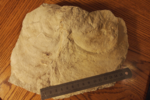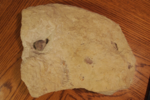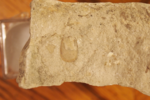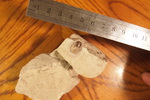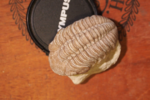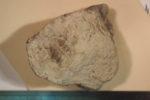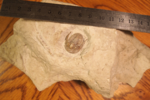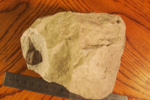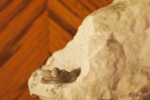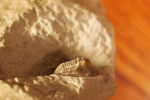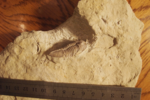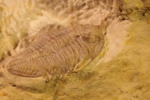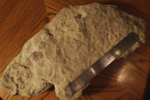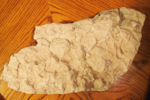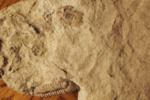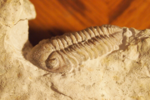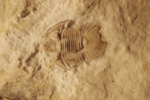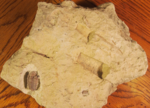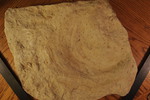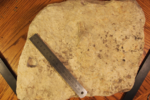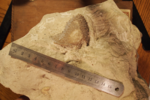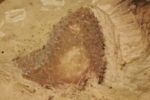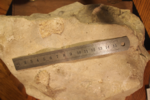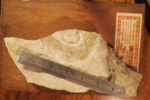
HUNTON BIOSTRATIGRAPHY
There are many reports on Hunton stratigraphy, and fossils from each rock unit have been classified and distinguished within several scientific
publications. Interpretations regarding specific bioassemblages however, are less numerous. This is probably because the “faunal zones” must be repeatedly observed in order that they may be
delineated and characterized. My knowledge of these aspects of the Old Hunton town site locality has been greatly aided by years of surface collecting, which began in the early 1980s, and has
continued since acquiring this outcrop in 2003. While certain trilobite horizons have been known about for decades that have yielded outstanding museum quality specimens, other trilobite layers
or zones within the Haragan and Bois D’Arc formations are also known to exist.
My experience with the Haragan formation has led me to believe that there are complete Huntonia trilobites within the beds beneath the Haragan bench, followed by a sporadic zone of up to 10 feet of vertical section that has Reedops deckeri trilobites, with perhaps at least more than one instance of a specific layer containing Reedops deckeri trilobites. Some feet below this zone are the layers that are commonly mined from the Haragan formation, which contain a number of different trilobites in variable associations that have been well documented at Black Cat Mountain.
Ten or twenty feet lower occurs an interval, or at least, a specific layer that features an association of Cordania falcata and Cyphaspis carrolli, along with other minor infauna and brachiopods that is traceable. There are one or more Paciphacops and Kainops associated layers above and below this “zone” within intervening strata. Some notable trilobite layers also exist at the bottom of the Haragan exposure that contain Huntonia and Paciphacops, along with other trilobites. The full extent of what could be anticipated from each layer within the outcrop would require extensive sampling. Then the order of the bioassociations that exist could be identified and characterized. Many trilobite species appear to occur in different assemblages throughout the Haragan formation.
It may be possible to recover specific aspects of paleocommunities solely based upon the presence of particular inarticulate and articulate brachiopods, different gastropods, various infaunal and epifaunal bivalves, variations in bryozoa and corals, or from demonstrable layers of cephalopods or echinoderms. The biological characteristics of the two formations at this outcrop are continuing to be discovered. There are associations that I have known about for some time, but many new observations are being made. For instance, there were no examples of the trace fossil Zoophycus within the Haragan formation that I had ever seen, and yet I have discovered more than a few instances of these trace fossils within the rock layers. Inarticulate brachiopods that were not reported upon within publications about this formation are now known from several examples. Small Pseudolingula type brachiopods are observed to be in life position when found, while most fossils are typically not in life position, unless they are infaunal bivalves or, in some instances, trilobites. Trilobite exuviae and isolated parts can be found in just about any strata within the outcrop, but the nature of the distribution concerning the complete trilobites is not that well understood. They are normally not in life position, but are known to be so within the well-known productive layers. And while there are some barren zones, there are also many productive horizons that contain whole trilobites within both formations.
Certain trilobites and brachiopods have been observed to form associations within the Cravatt member of the Bois D’Arc formation. These “biozones” occur within this unit as trilobite layers, that may be characterized by Huntonia lingulifer or Viaphacops sp. , and also as brachiopod horizons, noted by the presence of large Strophonella bransoni, or large-sized Rhipedomelloides oblata, Atrypa oklahomensis, and Leptaena rhomboidalis brachiopods. There are occurrences of trilobites like Cordania wessmani and Dicranurus hamatus elegantus that also appear within the Cravatt member. Most of these assemblages appear to be condensed within this member, and certain layers are appreciably thinner than are those found within the Haragan formation.
The beds within the Fittstown member of the Bois D’Arc formation, and in the succeeding Frisco formation which is exposed at the top of the mountain, are far less studied, and they are difficult to trace from lack of exposure. Normally all that is found are worn pieces and slabs lying about the slope. The lower Haragan formation is exposed, in limited amounts, within areas below the base of the outcrop. Here pieces of encrinite have been found, as well as cups of Scyphocrinites crinoids and bulbs. Normally only lengths of stems from these crinoids are recovered from this outcrop, although there is at least one layer within the Haragan formation that has noticeable lengths of stems.
The documented fauna of the Haragan and Bois D’Arc formations is not well featured within the scientific literature, as the most complete listing of the faunas was made by Maxwell (1936) within a Phd. dissertation at Northwestern University. Certain megafauna, such as the brachiopods and trilobites, are adequately supplanted with photographs and detailed descriptions in a number of readily accessible scientific publications. However, there is very little else that is readily definable. And yet a very diversified fauna is present within the outcrop area. New specimens that we have not seen before continue to be found, some of which are thought to be undocumented, and it only seems inevitable that many new organisms will come to light through further study of the outcrop. Perhaps of even more interest will be a more clear interpretation of how this exposure came to be, as well as the other outcrops nearby, like Black Cat Mountain. Studies involving this outcrop might allow a more reasonably defined interpretation about how it came to exist in this area.
The early Devonian Haragan and Bois D'Arc formations that contain this fauna are believed to be Lochovian in age. By association, based upon a comparison with other trilobite provinces, the trilobites are most closely allied to the Emsian trilobite faunas of Morocco and Bohemia, and to brachiopod and trilobite faunas of Tennessee. The ages of the Haragan and Bois D’Arc formations in Oklahoma represent the earliest part of the Devonian, and their relationship with the other similar trilobite faunas is speculative. These formations are now just slightly younger than the surrounding Henryhouse formation of late Silurian age, which has generally been accepted as youngest Ludlow within the outcrop area.
One particular notoriety that characterizes the Haragan formation is the presence of Reedops deckeri, which is not present in the succeeding Bois D’Arc formation. The genus Reedops is represented in the faunas of Morocco and Bohemia. This trilobite has been recently reclassified as a new genus named Lochovella, but I have retained the name Reedops for convenience, as this has been the accepted name for some time. The trilobites Viaphacops cf. bombifrons and Viaphacops sp. are found to occur within the Bois D’Arc formation. While many other genera or species of trilobites are present in both formations, these two phacopid trilobites are restricted in their occurrence. When Campbell (1977) cited Viaphacops trilobites as occurring only in the Frisco formation, his interpretation was based upon the only known specimens at the time. This trilobite is found as complete specimens within the Cravatt member of the Bois D’Arc formation at the Old Hunton town site locality, and is also known to occur in similar strata at surrounding localities. The types that were originally figured within Campbell’s publication were only represented by a few cephalons.
Different species of Huntonia trilobites I have found as complete or entire specimens in loose rocks just below the Haragan bench during my fossil hunting years ago. Occasionally, trilobite specimens have also been found in rocks that are noted to occur below the bench, where large amigdoidal chert nodules are seen. Fossils as a whole are much scarcer in the upper Haragan beds, such that these layers are much more difficult to discern from fragments or incomplete specimens. Below this interval there are series of strata that have yielded complete specimens of Reedops deckeri routinely, although this trilobite is also found in a number of other Haragan layers. At least one or more layers appear to exist that feature this trilobite exclusively within this interval.
Some feet below the Reedops deckeri interval are the beds that are well known to most trilobite collectors, as many fine specimens of trilobites have been collected at neighboring localities from these layers and sold or donated to various collectors and institutions. They routinely contain complete specimens of Huntonia huntonensis, Huntonia oklahomae, Huntonia linguifer, Paciphacops campbelli, Kainops raymondi, Ketternaspis williamsi, Reedops deckeri, Cordania falcata, Dicranurus hamatus elegantus, Ceratonurus sp., and Cyphaspis carrolli. There are a number of layers involved in this sequence, which could be considered of private reservation, but they are primarily underlain by layers that have not been identified as being very productive.
One has to search a number of feet below this interval for signs of a “zone” that is identified by the presence of Cordania falcata and Cyphaspis carrolli. Whole specimens of Cordania falcata are occasionally found upside down upon the surface of these rocks. Other times they may be found on the underside or within the layer. It is more the absence of other trilobites that distinguishes this interval, as most of the other parts that are found are small fragments of other trilobite species, and small brachiopod shells. This section within the middle portion of the Haragan formation is accompanied by different layers containing complete Paciphacops campbelli and Kainops raymondi trilobites, neither of which I have been able to trace significantly.
In general, the strata that form the exposure at the Old Hunton town site locality exhibit many unique depositional features that will require extensive sampling to qualify. Hopefully, some faunal elements will aid in deducing why variations exist within the different recognized bioassemblages. Unfortunately, there are many trilobite genera that are seldom found, such as Echinolichas and Breviscutellum, which do not appear to be range bound within any “zones”. There are no accurate or definitive reports regarding their stratigraphic relationships.
The outcrop at the Old Hunton town site has been known for some time. During the many years prior to my first visit, this outcrop had seen a parade of many parties of students and collecting society members through the decades that were allowed permission to forage its’ slopes for fossils. People who still remember these events describe them as hordes of ants crawling up the mountain. Most interesting to me was the recount that I was told by a resident who once lived here, and who remembered selling eggs for 5 cents apiece as a boy to a group of geologists who camped near the entrance to the outcrop during a time around 1930. He recanted that there were many neat slabs taken during the mining operation, and that they had quite a few nice fossils in them. The evidence of mining is still evident at the entrance to the Old Hunton town site today. It appears that whatever was done there was accomplished with pry bars and/or explosives.
The fact that there is so much information regarding the fossil faunas that is still retained at all upon the slopes of this mountain is a testament to its’ durability. The marlstone layers that exist here are weathered at a consistent enough of a pace as to reveal new specimens to the human eye over a period that most would consider impossible. Freezing and thawing of these rocks through the winter, along with some occasional heavy rain, does produce weathering effects that reduce the layers of rock into blocks. As these blocks continue to degrade, they break into smaller pieces. Each piece of rock may exhibit a fossil on any of the six sides that are exposed, because the fossils within the Haragan and Bois D’Arc formations are randomly oriented, such that they can appear almost anywhere within the rock.
In the past, I have found the use of cattle to be extremely helpful in overturning rocks and displacing them. The animals also tend to reduce the length of the grasses growing along the slopes. They maintain trails that are accessible to humans. And they provide nourishment to the many plant varieties that exist within the rock layers. They do not appear to harm the flowering plants, and until recently, we had cattle here through a lease arrangement that had free range over the outcrop for several years.
I will try to bring new updates here when more information about specific taxa comes to light regarding these faunas. There are many species of gastropods that are found here. There are also a wide variety of infaunal and epifaunal bivalves that have been observed here, and such enigmatic species as armored worms, and even less common fish remains. Other topics for discussion relate to the existence of blastoid and cystoid echinoderms, sponges, ammonites, and less than obvious crinoid species that are among the different sea creatures that are found here. Typical organisms of the Paleozoic, such as conularids, bryozoa, corals, ostracods, and graptolites are also present, as well as many encrusting organisms and stromotoporoids. There are faunal elements and trace fossils which exist here that can be used as diagnostic tools for determining water depth and wave energy, as well as to attest to the existence of currents. The outcrop itself is unique in its' geomorphology, and there are specific spatial regions present that are inherent, possibly due to original aspects of Devonian paleotopography.
copywrite California Dave @ huntonfossils.com
